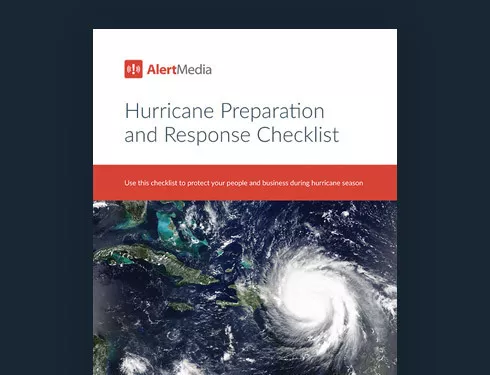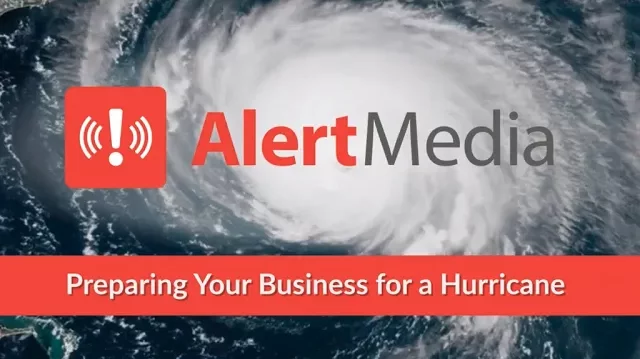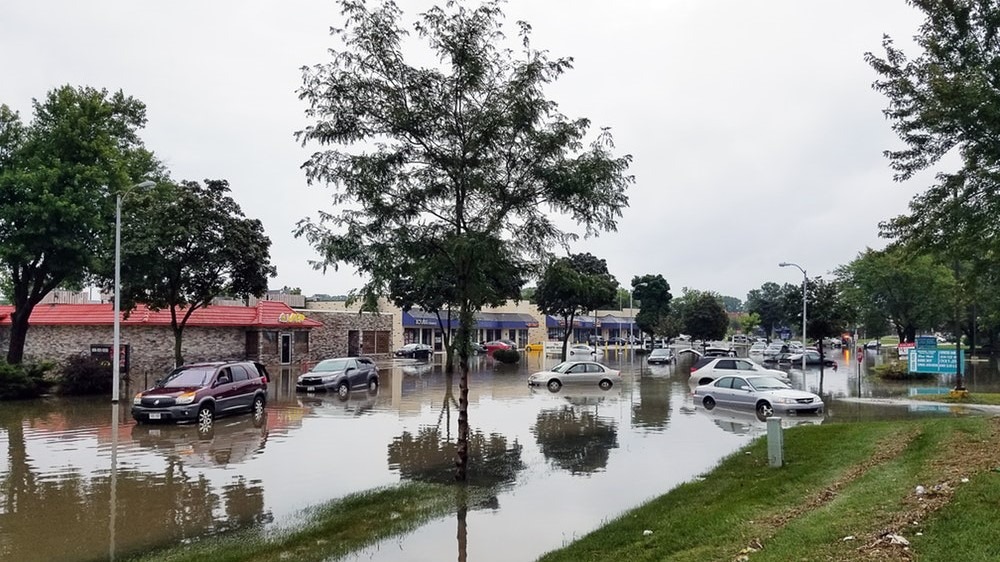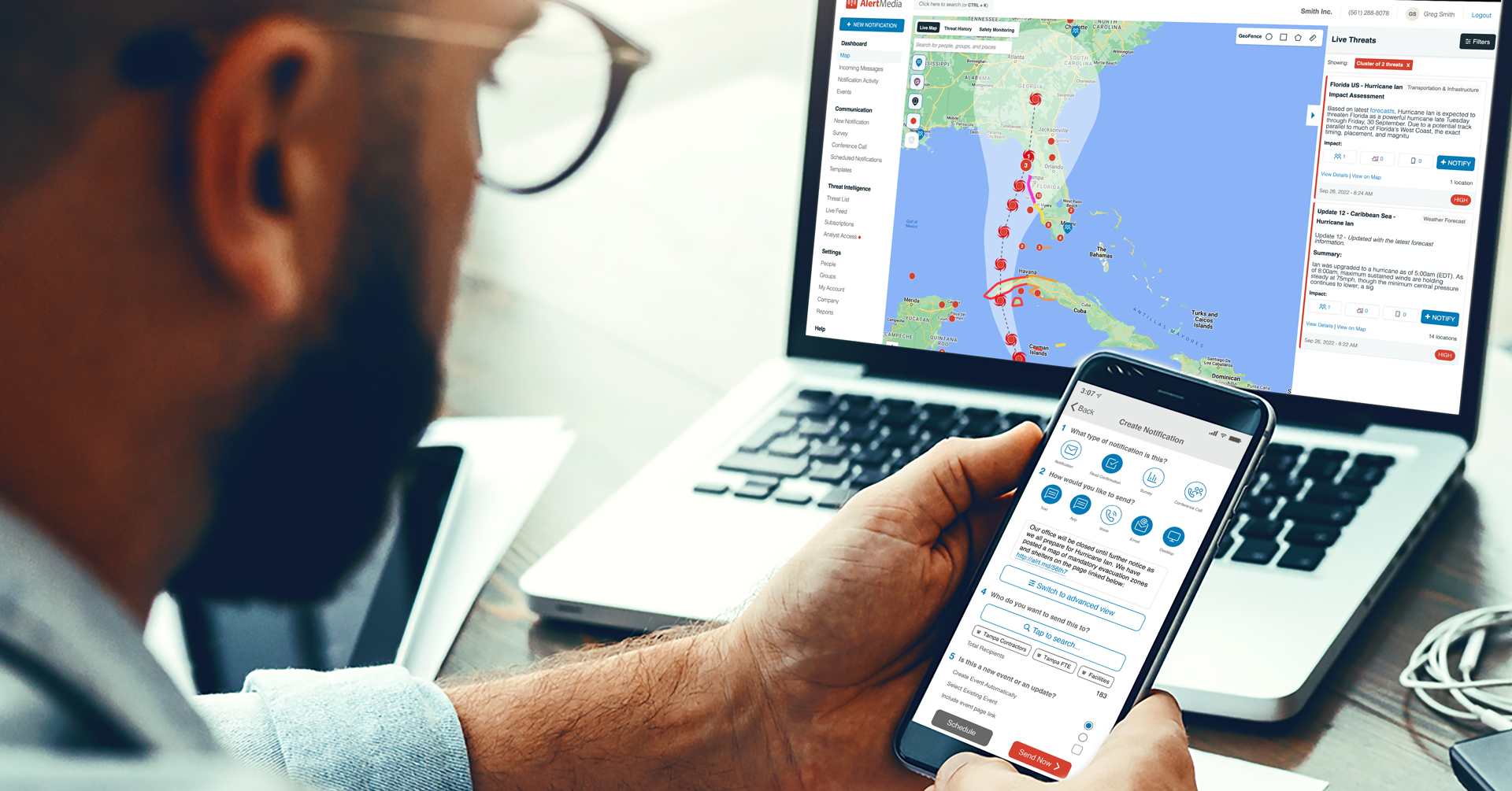
Hurricane Preparedness Plan for Businesses
Don’t wait until the storm is at your door to plan for this year’s hurricane season. Use this hurricane preparedness guide to protect your people and business.

With the 2025 Atlantic hurricane season rapidly approaching, now is the time for businesses to proactively prepare to safeguard their operations and employees during a storm. The season officially runs from June 1 to November 30, when tropical cyclones pose significant threats to coastal and inland regions. However, waiting until June to begin preparations won’t cut it. The 2024 season saw a record-breaking early Category 5 storm with devastating impacts along its path, so it’s critical to get your organization ready early in the year.![]()
Colorado State University released its first outlook for the 2025 Atlantic hurricane season, predicting 17 named storms, nine hurricanes, and four major hurricanes. The current 30-year average—already more active than previous long-term baselines—stands at 14 named storms, seven hurricanes, and three major hurricanes. Above-normal ocean temperatures and the lack of Pacific El Niño conditions will likely fuel a borderline hyperactive season. With a higher chance of landfall this season, spring is the time to prepare for hurricanes.
It takes only one bad storm to wreak havoc on your business and put your employees at risk. With today’s dispersed workforce, many businesses are having to prioritize hurricane preparedness for the first time. Preparing for this year’s hurricane season is a life-saving necessity for many businesses, and the time to start is before hurricane season begins.
The good news is that hurricanes, unlike other natural disasters—e.g., tornadoes or earthquakes—are foreseeable events, and organizations can take necessary steps to protect their people and businesses long before a severe weather disaster strikes. This post will outline how to prepare and respond effectively to the 2025 Atlantic hurricane season.
Download Our Hurricane Preparation and Response Checklist
“In 2022, we went from June all the way through August with really no notable storms across the U.S. or within its coastal waters. And all of this really significant activity came within a four-to-eight-week period in the forms of Hurricane Fiona and Hurricane Ian. So, there are going to be times when Mother Nature gives us a false sense of security—like maybe we dodged a bullet with this year’s hurricane season. But all it takes is a few-weeks-long window of favorable conditions for all of that to change.”
— Jason Moreland, Senior Meteorologist at AlertMedia
1. Conduct a Preparedness Assessment
You can’t protect what you don’t know exists. Before developing a hurricane preparedness plan, you must assess who and what will be impacted, including your people, physical locations, suppliers, and other assets.
People

Consider your people first. Before the pandemic, most organizations offered remote work as a perk. But today, nearly half of U.S. employees work from home in some capacity, and researchers predict many will never return to a corporate office.
For employees, remote work promises greater flexibility, better work-life balance, and lower stress levels. However, it means new communication challenges and business continuity concerns for business owners. Employees may choose to work from home or on the road. They may not even be in the same state as your organization’s headquarters anymore and, as a result, could be impacted more significantly than others. At the same time, most homes aren’t equipped with the appropriate technology, disaster supplies, or infrastructure to stay up and running during a hurricane. IT failures and other issues like power outages become more frequent and complex to fix.
To avoid any confusion, keep an accurate, up-to-date employee contact list. Use an emergency communication system to send notifications to employees every few months, instructing them to respond if they receive the message. Your HR department can then follow up directly with those who don’t respond to verify whether their contact information has changed.
Suppliers
When Hurricane Harvey hit in 2017, it caused outages in all Gulf Coast refineries, reducing the U.S. gasoline refining capacity by more than 20%. That same year, Hurricane Maria caused a shortage of drugs, medical supplies, and medical devices in hospitals across the U.S. And let’s not forget Hurricane Florence and its effect on livestock and agriculture. Thousands of hogs died during the storm, disrupting the food chain.
“Even if your organization exists miles away from a hurricane-prone area, supply chain and travel disruptions may cause logistical issues or disrupt deliveries.”
The point is that a severe storm may not just impact your business—it can affect other organizations you rely on to conduct business. Even if your organization exists miles away from a hurricane-prone area, supply chain and travel disruptions may cause logistical issues or disrupt deliveries. Therefore, your preparedness plan should address how to account for business interruptions and potential delays and communicate with suppliers during an emergency.
Locations & assets
According to the Federal Emergency Management Agency (FEMA), many businesses never fully recover after a disaster. Part of the reason involves damage to physical locations and loss of critical data. Additionally, many companies cannot withstand the financial pressures caused by extended downtime. As a result, disaster recovery teams need to know the location of sensitive data and critical assets at each site and how a hurricane may impact them.
Experts recommend backing up your data on-premises, at a remote site, and in the cloud to ensure multiple layers of redundancy. You may even want to consider relocating physical assets to a more secure location before an oncoming storm. Finally, review disaster and flood insurance policies and determine what, if any, documentation requirements your insurance company has in place.
2. Build Your Emergency Plan
Business continuity and emergency planning are critical to an organization’s ability to withstand the impact of a hurricane. A business continuity plan will also help you understand your priorities before, during, and after a storm to get your business back up and running as quickly as possible. Let’s walk through the critical components of an emergency plan.
Develop a system for detecting and monitoring threats
The first step in any effective response is the early identification of the threat. The more time you have to prepare, the better your plan will be. But that doesn’t mean you must stay glued to the television 24/7, eagerly awaiting the weather report.
Instead, implement threat monitoring capabilities that share up-to-the-minute threat data from trusted sources worldwide. When organizations rely on sites like weather.gov to track a hurricane, they must cross-reference that data with a list of office locations and employee home addresses, which takes a lot of time and resources—things you’re lacking during an emergency.
“Slow-moving storms tend to increase the risk of flooding as they continuously dump water in the same area for hours or days. Be especially careful about floodwaters during and after a hurricane inches past you.”
Access to threat intelligence can also help you track the storm’s severity. Before a storm officially becomes a hurricane, it starts as a tropical depression—often far from shore. However, a tropical depression can quickly morph into a tropical storm that will bring heavy rains, potential flooding from storm surges, and water damage. Knowing when that transformation occurs will help you brace for impact. If the tropical storm intensifies, you’ll know you need to prepare for possible structural damage and emergency evacuation.
AlertMedia’s Global Threat Intelligence proactively identifies whether your employees may be in the path of an approaching storm and automatically sends you a hurricane warning with details about its severity and which of your people and assets may be impacted. In addition, it uses mobile location data to understand your people’s whereabouts in real time. Companies can easily see each user’s location on an interactive map, accessible via desktop and mobile devices.
Assemble your emergency response team
When it comes to protecting your people, assets, and locations—it takes a village. For that reason, it’s essential to form an emergency response team to help manage your plan’s moving parts. Your team should involve people from various departments across your organization, including:
- Safety and security teams
- Representatives from HR
- PR or internal communications personnel
- At least one C-level executive sponsor
Ensure each person understands their unique role and responsibilities, whom they report to, and what resources and technologies they need to do their job effectively. Supply them with a copy of your emergency response plan, and schedule a training session to run everyone through it with the opportunity to ask questions. You may also want to consider supplying each member with a disaster preparedness toolkit, including details such as the locations of offsite evacuation zones and lists of local emergency phone numbers to contact. Peter Steinfeld discussed this and other mitigation strategies on The Employee Safety Podcast.
—Millie Starliper, IBM
Once you’ve assembled your team, practice your plan with emergency drills. Ensure everyone feels comfortable with their role and can remain calm during a real-life emergency. During the exercises, walk through the evacuation plan and hurricane preparedness checklist for your business, and if some pieces of your framework don’t work, update your plan to reflect new protocols.
Outline your response
Your final step in building your emergency response plan requires creating a specific response for all potential safety hazards. Some responses might include closing your office, turning on backup generators, coordinating recovery efforts with local officials or Red Cross responders, or providing employees with a suggested evacuation route and/or emergency shelter location.
Once response plans are in place, train all employees to take action. Practice various hurricane scenarios and remind employees about the importance of communicating with them in real time. During a disaster, people will be slow to respond to email, so make sure you have multiple channels available for emergency alerts, including phone, text, mobile push notifications, and even social media.
Include a hurricane preparedness checklist in your plan
As a best practice, consider developing a hurricane checklist of things you must do before, during, and after a storm. Your checklist should include tasks such as inspecting the office and your equipment—everything from your data centers, backup chargers, and propane tanks to drinking water, flashlights, extra batteries, and gutters—to identify which items you still need to obtain in advance. A well-structured hurricane checklist enhances your emergency plan by providing a clear, actionable framework for leadership and employees. Here are some essential checklist items to include for each stage of the storm:
Before
- Assess risk: Identify at-risk facilities, data centers, critical assets, and employee locations.
- Take inventory: Document physical assets, secure important documents, and backup data (on-site, cloud, and remote).
- Review policies: Ensure insurance is current; HR should align policies for remote work, evacuation, and pay during closures.
- Prep supplies: Stock up on water, non-perishable food, flashlights, batteries, chargers, a weather radio, and first aid supplies.
- Secure buildings: Board windows, sandbag entrances, and relocate vulnerable equipment.
- Check communication systems: Test emergency communication platforms across text, call, email, and push notifications.
- Practice drills: Run through your emergency plan with employees and conduct mock scenarios.
During
- Monitor alerts: Track updates from NOAA or a threat intelligence platform.
- Shelter in place: Do so if needed, and maintain contact with remote and on-site teams.
- Send updates: Use your mass notification system to issue real-time safety updates.
After
- Check-in: Perform a post-storm status check to ensure employees are safe and accounted for.
- Initiate recovery: Begin damage assessments, cleanup, and business resumption.
- Communicate next steps: Clearly and frequently inform employees about return-to-work expectations and ongoing support.
3. Secure Your Facilities and People
Businesses closer to the coastline will typically experience more significant property damage than those further inland. However, the risk of high winds and floodwaters can still affect organizations even hundreds of miles from the center of a storm. Therefore, your emergency response plan should address how to secure your indoor and outdoor facilities.
Protection for your external buildings includes boarding up windows and doors, placing sandbags outside any openings to your office, and ensuring you have a backup power system to keep all critical security assets working, including cameras, fire, and burglar alarms.
For the interior of your building, consider moving all important documents, furniture, and IT equipment away from windows or even relocating them to a safe location. If employees will be working in at-risk areas, make sure you know where your first aid kit is located, and instruct staff to take home any personal belongings. You may also want to consider stocking up on non-perishable food items and water bottles and turning off gas and water.
“If you can, providing emergency materials to your employees and their family members is a powerful way to manage the impact of a hurricane.”
Remember, the number of assets and facilities you need to secure depends on your business and industry, so work with your emergency response team to identify all potential risks.
Beyond your physical facilities, you also have a duty of care—a moral and legal obligation to protect your people from unnecessary risk of harm. Hurricanes aren’t quick incidents, and forecasts can change rapidly, which may impact your response plan. To keep your business running and your people safe, you must constantly communicate with employees as hurricanes unfold.
Implement an emergency communication system that offers multi-channel, two-way communication capabilities to ensure all employees receive the information they need when needed. Email alone won’t suffice, especially if an employee finds themselves in the danger zone. You need the option to warn them in real time while providing them with relevant information that will help keep them safe. Knowing most employees have cell phones, send messages via text message, phone call, push notification, and email. More hurricane-savvy companies will often keep a list of employees’ loved ones who may need to be notified of an emergency. Keep up-to-date hurricane notifications going before and during the storm so employees know what’s coming and what to expect and that your company has eyes on them to keep them safe throughout the storm.
Communication doesn’t end when the storm does. Keeping people informed immediately following a hurricane is just as important. Check-in on employees’ well-being by sending out daily wellness check surveys. Consider also creating a resource or event page where employees can go for updates on when the office will reopen, any alternate working plans, and how operations may be impacted.
Anyone in the potential path of a hurricane must have a well-stocked emergency supply kit. Here is a list of items you might want to include in your kit.
- Waterproof containers
- Bottled water
- Extra batteries/chargers
- Hand sanitizer/PPE
- Essential documents like insurance info
- Non-perishable food
- First aid kit
- Battery-powered weather radio
- Prescription medications
Sample Hurricane Preparedness Plan for Business
Now that we’ve covered the essential components of a hurricane preparedness plan, let’s examine what it looks like in practice. Below is an example of a hypothetical company with three offices on the United States East Coast.
Remember, each organization’s hurricane safety strategy will vary depending on its geographic location, the kind of work it does, and its philosophy regarding emergency preparedness. What works for an enterprise-level tech company may not be helpful for a local small business. Don’t use this plan for your business unless you take the time to tailor it to your situation.
Before the storm

- Track the storm’s progress from sources like the National Weather Service (NWS).
- Plan evacuation routes.
- Create an emergency communication plan that includes everyone in your organization and any third parties who may need this information.
- Determine a secondary location where business can resume if the main offices are unusable.
- Ensure that employee contact info is up to date in all three offices.
- Designate safe sheltering areas for employees.
- Back up and turn off server equipment.
- Inspect structures such as roofing, gutters, windows, storm shutters, etc., and repair if necessary.
- Communicate with everyone so that they know the storm is approaching and that safe evacuation routes are available away from the office.
- Disconnect electrical mains in all three offices to avoid an electrical fire.
- Note the location of vulnerable power lines.
- Double-check that all emergency supplies, backup emergency generators, and emergency kits are readily available and in good condition.
While a business can’t control where a hurricane hits or how damaging it will be, early planning is essential to minimize the impact. This video will help your business protect your organization and people if a hurricane lands in your area.
During the storm
- Observe the storm’s movements from a safe place using radio and the internet, if possible
- Shelter in place and stay safe
After the storm
- Continue with the hurricane watch, and pay attention to any warnings from local authorities.
- Reach out to all of your people and perform a post-storm status check—find out if your people are okay, need help, or are in a position to assist others.
- Initiate your recovery plan and restart business operations once everyone is accounted for.
- Offer support to all employees. Due to our coastal location, many might need support beyond immediate disaster relief.
Employee-specific readiness
Employees will be an integral part of your hurricane response and recovery, but they will also likely be navigating the storms at their homes with their families. So, investing in your employee preparedness is a helpful element of hurricane preparations. Help your employees by encouraging the following:
- Know the plan: Ensure employees understand evacuation routes, shelter-in-place protocols, and how to secure their workspaces.
- Stay informed: Share key contacts and explain how your emergency notification system works.
- Be proactive: Recommend that employees prepare personal emergency kits at home and in their vehicles.
While your business may have strong hurricane protocols in place, employees also need to feel confident and prepared on a personal level—especially those working remotely or traveling in storm-prone areas. When individuals know how to protect themselves and their families, they’re better equipped to respond calmly and effectively. Encourage your entire team, regardless of location, to take the following steps to prepare their homes, vehicles, and travel plans for the possibility of severe weather. Personal readiness enhances safety and strengthens your organization’s overall resilience.
- Fill your gas tank and keep devices charged ahead of time.
- Close and secure all windows and doors.
- Unplug electronics and secure outdoor items.
- Keep emergency contacts and vital documents in waterproof containers.
- Make sure each family has an evacuation plan in place at home.
The Importance of Preparedness
As we enter this extremely active season, it’s critical to stay proactive, develop a holistic communication plan, and have the right technology to support it. AlertMedia is a modern solution that combines next-level threat monitoring with industry-leading emergency communication that promises to take your organizational resilience to the next level while keeping your people and assets safe.
Hurricanes can be intimidating, but with proper preparation and the right tools, you can ensure your people and business can weather any storm safely.





